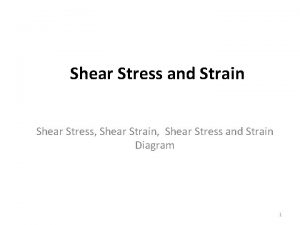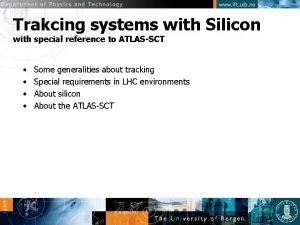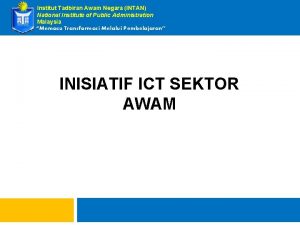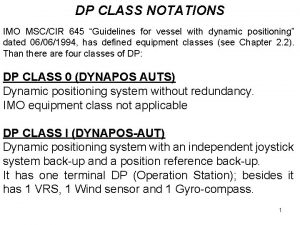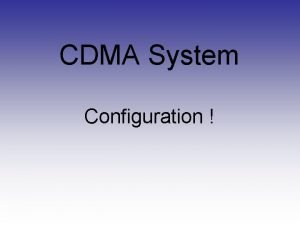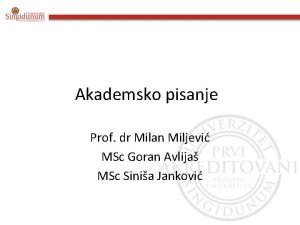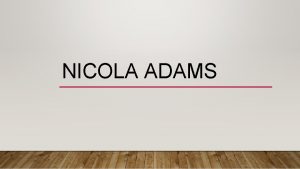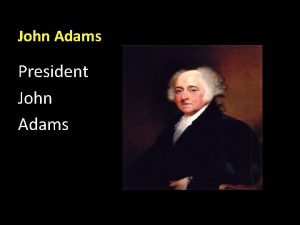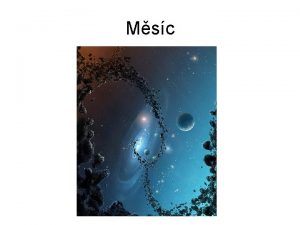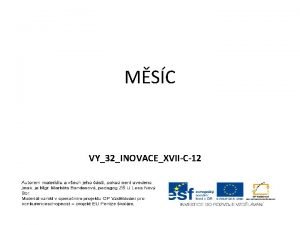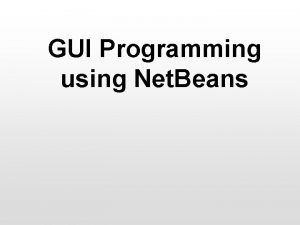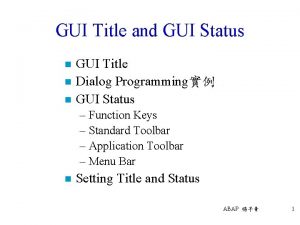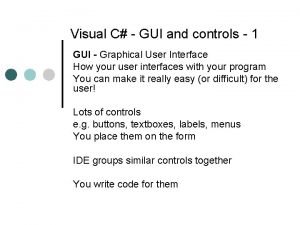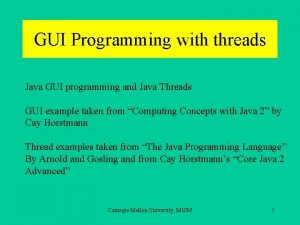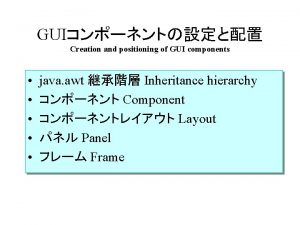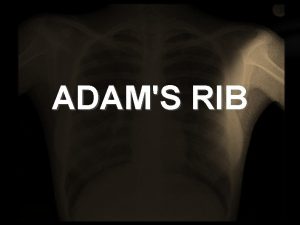Using MD NastranPatran and MSC Adams together GUI






















- Slides: 22

Using MD Nastran/Patran and MSC. Adams together GUI Familiarity Level Required: Advanced Estimated Time Required: 40 minutes MSC. ADAMS 2005 r 2 1

Topics Covered In this tutorial you will learn how to: 1. Generate a. mnf file from Nastran 2. Import a. cmd file into ADAMS 3. Replace rigid body with a flexible body in ADAMS 4. Animate modes in ADAMS 5. Set damping ration in ADAMS 6. Create FEMDATA with peak. load for Nastran in ADAMS 7. Set output in ADAMS 8. Run dynamic simulation in ADAMS 9. View results in ADAMS Postprocessor 10. Perform stress recovery using Nastran 11. Process stresses using Patran 12. Attach results from a Nastran XDB file in Patran 13. View Results in Patran You will need to download “FEMDATA_starting_files. zip“ to begin this tutorial If you have any difficulties, import the “FEMDATA_shortcut_1_files_exported_from_Nastran_1. zip” file and proceed from pg 6 If you have any difficulties, import the “FEMDATA_shortcut_2_files_exported_from_ADAMS. zip” file and proceed from pg 16 If you have any difficulties, import the “FEMDATA_shortcut_3_files_exported_from_Nastran_2. zip” file and proceed from pg 17 If you have any difficulties, import the “FEMDATA_complete_files_exported_from_Patran. zip” file and proceed from pg 19 2

Problem Statement This example demonstrates the output peak loads from an MSC. ADAMS simulation for a flexible component using FEMDATA. The loads are output in MD. Nastran input file format and solved for stresses. These stresses are viewed in MSC. Patran and compared with the modal stresses in MSC. ADAMS for the same component and simulation. The syntax for the FEMDATA and OUTPUT statements are: FEMDATA/1, LOAD, FLEX_BODY=1, PEAK=FX: FY: FZ, FILE=peak. loads OUTPUT/LOAD = NASTRAN The MSC. Nastran input file to compute an MNF for the flexible component is provided (left_lca. data). This file references an MSC. Nastran mesh file, left_lca. bdf. Left_lca_load. dat is an MSC. Nastran input file used to perform a static stress analysis of the component using peak loads from MSC. ADAMS. It also references the same mesh file 3

Model Description The model is an all-terrain vehicle (ATV) standing on a four-post test rig. Each post moves vertically and independent of the other posts to stimulate the ATV running over rough terrain. The model files for this example can be found in your MSC. ADAMS installation directory (…/durability/examples/ATV). All parts of the model are rigid. An MSC. Nastran model of the left lower control arm (LCA) is provided to replace the rigid part with a flexible body. Another MSC. Nastran input deck is provided to compute stress for this component due to loads from MSC. ADAMS. 4

Generate the flexible body MNF in MSC. Nastran a. Start MSC. Nastran b. Browse files and select left_lca. dat c. Click Open b The Msc. Nastran Command Information dialog box will open d. Enter scr=yes in Optional keywords text field (This removes the bulky. MASTER and. DBALL database files after MSC. Nastran run has completed) e. c Click Run (This Nastran run may take 5 -10 minutes, depending on your computer resources. Upon successful completion, the run will produce an MNF names left_lca_0. mnf. If this file is not created, scan the left_lca. f 06 file for FATAL errors. ) d e 5

To Import the Model into ADAMS/View NOTE: the ATV model requires a huge memory setting to simulate in ADAMS/Solver (FORTRAN). Before starting your ADAMS/View session, make sure that your memory setting is set to Huge. a. Start ADAMS/View. b. Select Import a file radio button c. Click OK The file import dialog box will appear d. In the File To Read text field, enter ATV_4 poster e. Click OK b c d (There is no need to search for the model file, ATV_4 poster. cmd, because the model is used in an ADAMS/Durability tutorial, it is part of the MSC. ADAMS installation (…/durability/examples/ATV); ADAMS/View knows how to locate it and all the. shl files it references. ) e 6

ADAMS/View Model 7

Replace the rigid LCA with a flexible LCA a. Select Build menu Flexible Bodies Rigid to Flex b. In the Alignment tab, select the rigid part you want to replace and the model neutral file as follows: Current part = RB 2_left_lca_59 MNF file = left_lca_0. mnf Note that the flexible body defined in the MNF is already correctly positioned b a 8

Replace the rigid LCA with a flexible LCA a. Select the Connections tab. The table displayed compares the connection points on the flexible body with those on the rigid body. Note that there are four bushings connecting the part to the model at these markers: BUSHING_1 MARKER_1000052 BUSHING_2 MARKER_1000017 BUSHING_9 MARKER_1000052 BUSHING_11 MARKER_1000069 These four locations will be used later to generate peak loads for MSC. Nastran. In the Distance column, you will notice that there is a small offset for the four bushing connection points. Keep the bushings at the points where they were originally defined in the rigid model. b. Select rows 1 through 4 in the table c. Select Preserve Location button d. Select OK a c b The Flexible Body defined in the. mnf has replaced the rigid part. The flexible body is connected to the frame, knuckle, and damper the same way the rigid body connected. d 9

Animate the modes of the flexible LCA b c d a. Zoom in on the left LCA in the front suspension b. Right click the flexible LCA, select Flewiblw_Body: RB 2_left_lca_59_flex Modify c. Enter 7 in the Mode Number text field d. Click Animation tool (You can animate any of the 40 modes calculated by MSC. Nastran and imported from the. mnf. The first mode of interest is mode number 7, since modes 1 -6 are rigid body modes and are automatically disabled) 10

Modify the damping ration of the flexible link a. In the Flexible Body Modify dialog box, clear the default checkbox next to Damping Ration b. Enter the following function for the Damping Ration text field STEP(FXFREQ, 1000, 0. 005, 10000, 1) This means: Modes with a frequency below 1, 000 Hz will have a 0. 5% damping ratio The damping ration will increase for modes in the range 1, 000 – 10, 000 Hz according to their frequency based on the STEP function. Modes with a frequency above 10, 000 Hz will be critically damped (100%) Note that default damping would use a 10% damping ratio for mode 7, which is too much damping for a component made of steel. c. Click OK b c 11

Create FEMDATA with peak loads for Nastran a. Select Build menu Data Elements FEMdata New b. Select Loads On Flew Body from Type pull down menu c. Enter RB 2_left_lca_59_flex in Flex Body text field d. Turn on FX, FY, and FZ checkboxes for Peak Slice e. Enter peak. loads in file text field f. Select OK to close the Create FEMDATA dialog box b c d a e f 12

Set output a. Select Settings menu Solver Output In the Solver Settings dialog box set: b. Save Files: Yes c. Graphics File: No d. Request File: No e. Results File: No f. Turn on the More checkbox g g. Select Durability Files from Output Category pull down menu h. Select NASTRAN from Component Loads pull down menu i. Select Close to close the Solver Settings dialog box h b c d a e f i 13

Run the MSC. ADAMS dynamic simulation a. Select Simulate menu Scripted Controls b. Enter SIM_SCRIPT in Simulation Script Name text field c. Turn on the Reset before and after checkbox d. Turn off the Update graphics display checkbox e. Click Play. a The simulation will take a few minutes to complete. Each post that the ATV is standing on will move up and down to simulate the vehicle running on rough terrain. You could have also done this using tire forces and a road profile. A result of the FEMDATA definition is that a file named peak. loads is generated at the end of the simulation. This file contains the loads acting on the flexible LCA for each output step when each load reached a peak (maximum or minimum value -2 instances). These loads are defined using MSC. Nastran load cards, and each step that is output becomes a load case in MSC. Nastran. Because you specified 3 load components (FX, FY and FZ). And the flexible LCA has 4 load points, a total of 24(2*3*4) load cases are output. Confirm this be examining the load file in a text editor. e b c d 14

View ADAMS results a. Open ADAMS/Postprocessor (F 8) b. In the Dashboard, specify the following b. Source: Objects c. Filter: force d. Object: BUSHING_9 e. Characteristic: Element_force f. Component: Mag g. Click Add Curves Note that this is the force of the bushing connecting the LCA at MARKER_1000052 to the spring damper. Check the peak. loads file for consistency. c d e f b 15 g

Perform Stress Recovery Using MSC. Nastran a. Start MSC. Nastran b. Browse directory for file left_lca_load. dat c. Click Open d. In the MSC. NASTRAN Command Information dialog box, enter scr=yes in Optional keywords text field e. b Click Run This Nastran run should take a few minutes depending on your computer resources. The run will create a file named left_lca_load. xdb. This file contains the displacements and stresses for each load case, and will be imported into MSC. Patran for postprocessing. c Note: You should scan left_lca_load. f 06 for FATAL or WARN messages. You must resolve any issues before continuing. d e 16

Postprocess stresses using MSC. Patran a. Start MSC. Patran b. Create a new MSC. Patran database (. db file) by selecting File menu New c. Enter WTSC_atv. db in File name text field d. Click OK a b c 17

Attach results from a Nastran XDB file in Patran a a. Click Analysis main icon b. Select Access Results from Action pull down menu c. Select Attach XDB from Object pull down menu d. Select Both from Method pull down menu e. Click Select Results File button f. Select File dialog box will appear f. Browse directory, select left_lca_load. xdb file g. Click OK h. Click Apply b c d f e g h 18

View Results in Patran a a. Click Results main icon b. MSC. Patran displays a lit of 24 subcase that represents a time frame from MSC. ADAMS b. Highlight all 24 subcase to see entire animation 1. (you can choose 1 subcase if you would like to see a select frame in time) c. Click Stress Tensor from Select Fringe Result d. Click Displacement, Translational from Select Deformation Result e. Click Apply b c d e 19

Results 20

Topics Covered In this tutorial you will learn how to: 1. Generate a. mnf file from Nastran 2. Import a. cmd file into ADAMS 3. Replace rigid body with a flexible body in ADAMS 4. Animate modes in ADAMS 5. Set damping ration in ADAMS 6. Create FEMDATA with peak. load for Nastran in ADAMS 7. Set output in ADAMS 8. Run dynamic simulation in ADAMS 9. View results in ADAMS Postprocessor 10. Perform stress recovery using Nastran 11. Process stresses using Patran 12. Attach results from a Nastran XDB file in Patran 13. View Results in Patran 21

Best Practices • Check f 06 files for warnings or errors. • Verify that when flexible body is imported it has the right orientation and location. • Verify all variables are set correctly. • Verify FEMDATA is created correctly. • Verify Nastran as output. • Make sure you are using correct files during procedure. • Make sure that the results are correctly set. • Verify that results are consistent. 22
 Define john quincy adams
Define john quincy adams Ge gi gue gui güe güi
Ge gi gue gui güe güi What fires together wires together
What fires together wires together Msc in construction law
Msc in construction law Bsc and msc in telecom
Bsc and msc in telecom Msc finance and banking tor vergata
Msc finance and banking tor vergata Ssy in machine design
Ssy in machine design Msc trakcing
Msc trakcing Msc traction
Msc traction Hapag qq
Hapag qq What is an msc?
What is an msc? Almacenes msc
Almacenes msc Grenoble ecole de management msc finance
Grenoble ecole de management msc finance Prof msc
Prof msc University of birmingham msc international business
University of birmingham msc international business Jma msc
Jma msc 7 aplikasi perdana msc
7 aplikasi perdana msc Msc sirkka
Msc sirkka Consequence analysis dp
Consequence analysis dp Network msc
Network msc Msc eir
Msc eir Msc sandra
Msc sandra Prof dr milan miljevic
Prof dr milan miljevic






